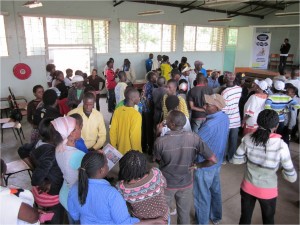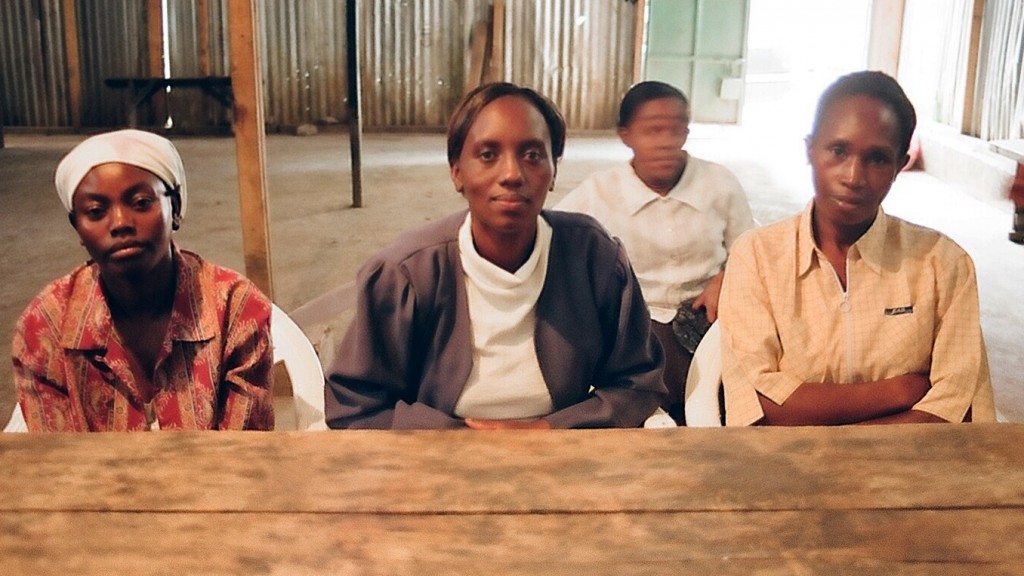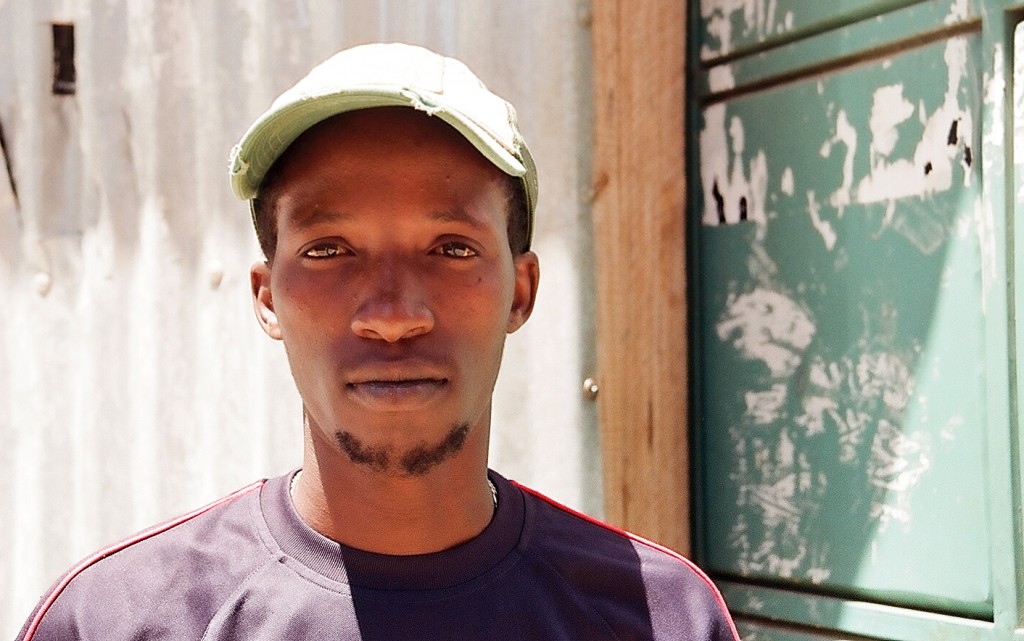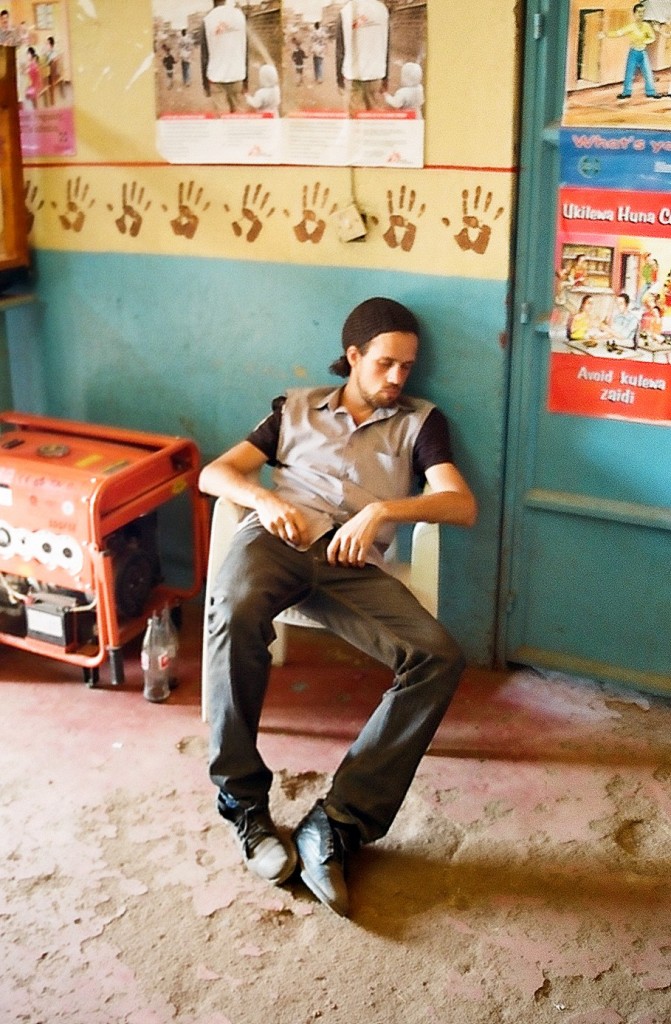by: Erica January 29th, 2011 comments:
By far the most striking thing for me about Kibera – the most unexpected and most challenging – has been working in what I consider to be an artificially-constructed economy.
That is to say, there are no simple volunteer projects in Kibera. At least, none founded by outsiders.
This has been an evolving thread through our work and has upended some of our original thinking on open-source or simply, development projects. You might say we were merely naive. Why on earth would anyone living in dirt-poor conditions want to “volunteer” just for the good of their community? Have you met a lot of jobless people in America or Europe who can barely feed their children, wear threadbare clothes and shoes, and have to pay to use a dirty latrine piping up to volunteer on raising awareness on HIV?
It’s an unfair comparison, I know. The fact of the matter is that in the slums one might volunteer to clean up the latrines or build a new one, simply because no one else is going to do it for them. And someone with HIV or whose family members are affected might well wish to spread the word about prevention. And certainly there are many, many true volunteers – they just tend to be starting things themselves from within Kibera, and hoping things will turn around soon.
We hoped that the value of the trainings we were offering would be in and of themselves enough. We also hoped that motivation would come from a desire to improve Kibera, the kind of community motivation that would be a matter of pride and would perhaps stem from a sense of the systemic injustice represented by a slum. Personally, I probably had thoughts of working in Latin America, where indigenous communities have often self-organized and pushed very hard on social justice issues, where poverty itself is seen as a justice and human rights issue, and there is a long legacy of social thought and philosophy underpinning most community-based organizations.
What we found, instead, is a community so influenced economically by years of “interventions” by various international development organizations that a full shadow economy has developed. It’s not the black market – it’s the shadow aid market. Ask any Kibera resident about jobs they’ve held in the past and most will mention some volunteering with aid agencies or small NGOs in the community. And by “volunteering” they mean getting paid to do a job. It’s evidence of the perversion of donor dollar influx that the very term Volunteer connotes something completely different here than it does anywhere else. What has happened is that well-meaning organizations have set up projects in Kibera (thousands of them) and thereby actually created a “market” for participants in those programs. There are so many NGOs here that the demand is actually for Kiberans to take part, rather than the other way around. Of course, we felt that our project was different, and perhaps it is – a kind of meta-project created to make public all of the information that these hundreds of organizations were collecting, to allow direct self-mediation (non-mediation?) of information, news and stories, to hopefully drill a hole through the cacaphony of aid-speak about Kibera and allow a few actual people to speak through and tell the truth.
This was – and still is – our vision. But the economic conundrum remains. Kibera residents have learned that these NGOs need them – that they’re getting paid and raising a great deal of funds in order to develop programs and fill their presentations, events, workshops, and trainings with bodies. Kiberans have wised up to the fact that sometimes they’re being “sold” by agencies to donors even if the project hasn’t really made them better off – after all, who asked them? – and there have even been a few oft-repeated tales of random small children being photographed in Kibera with a white person who then used the photos to raise funds for their own pocket. (Of course, this is why we’re trying to create platforms of transparency – ways for people to disclose what’s happening in the community and expose the gaps). Kiberans whisper about ending up on billboards in America without a penny to show for it. Whether true or not – it’s probably happened, and then rumor made it sound like the norm – this shows the distrust that has developed under the welcoming Kibera surface. We’ve had arguments with participants to convince them that no, most white people don’t come to Kibera to get rich! This also explains why tourists shouldn’t simply wander through with their big cameras and photograph people, as they so often do. It hints at a much deeper recognition of the complicated, often contradictory relationship between the thousands of well-meaning white people who find their way to Kibera and those who live there every day, and the lack of any meaningful way for Kiberans to guide those relationships – coupled with their frequent dependency on them. There is an unwillingness to challenge openly a system that might one day prove to supply one of the few real jobs that are at hand – the coveted NGO position. (For me, this was frustrating since we set out to co-develop a project not fill it with employees – see part 2).
Eventually, there emerged an expectation of a “sitting fee” to attend someone’s meeting – yes, organizations paying people just to fill the seats in their events. This complicated our initial attempts to hold community meetings around the issue-based maps. The first one was organized by Regynnah, a mapper, on the topic of health. It was held in Raila, her own village. There were a good 30 people and it was a great success. However, we only gave out sodas to participants, no money or phone airtime. Regynnah came to us afterward and said now her contacts were mad at her because they expected to be paid for this 1-2 hour discussion of health – even though most of them were health practitioners and ostensibly interested in the topic. We hoped instead they’d be able to make use of the information – not demand a sitting fee.
We tackled this by making sure people knew in advance that no one would be paid for such discussions – meaning they might attract fewer people, but ones who are more intrinsically motivated to participate – and in fact, sometimes only 4 or 5 people showed up.
It was a challenge to us as well. We had to make these activities really worth their while, and create a working relationship based on trust that could lead to improvements in the sector in question. A lot more thinking went in to producing projects that would really engage communities and be driven by them as well as for them. We continue to unravel the idea of how to support people to share information in such a way that it changes the status quo in Kibera – how to complete the feedback loop and help people use technology to achieve their goals. The shadow economy, though, pulls people in different directions and in some cases fosters splintering of organizations and groups.
I do believe strongly that there needs to be a more equal exchange between any outsider and the Kibera people. This has informed a lot of our work trying to consolidate information in an open system rather than constantly requesting Kibera residents to answer surveys and participate in focus groups that will never have visible benefits to them (much less reports back on the findings). I’ve been appalled by many NGOs’ and researchers’ total disregard for the worth of each person’s time and energy – perhaps a sitting fee should apply when research is done in this traditional, extractive way. One problem is that too often Kiberans profess excitement over any new project and pin their livelihood (and other) hopes on it, encouraging absolutely everyone that whatever hair-brained idea they came to Kibera is the greatest thing since sliced bread. Not to say this happened to us ;)
More on livelihoods and working with our Trust team in Part 2…
This post is part of a series exploring the ideas and issues that have emerged in our research project with Institute of Development Studies, supported by DFID. All posts from the Map Kibera team, the researchers from IDS, our trainers and colleagues are collected here. As always, we are eager to discuss this work, so we hope to hear your comments.
by: jamie January 24th, 2011 comments:
“Participatory methodology (PM): A combination of approach and methods through which people do things themselves interactively. What they do may be appraisal, analysis, planning, action, learning, changing, monitoring, evaluation or other activities”
Robert Chambers. Paradigms, Poverty and Adaptive Pluralism. IDS Working Paper 344. July 2010
Map Kibera did not begin as a participatory development project. The initial project was an attempt to introduce open source technology – namely, OpenStreetMap – into a community that had previously not had a publicly accessible map (for all intents and purposes it was “unmappedâ€). Initial mapping of Kibera was done quickly (in 3 weeks) and local leaders, including administration were consulted but not necessarily engaged in the process. Interest from the international community and the innovative nature of the project fueled its expansion and the local community was left behind.  The entire Map Kibera team has been reflecting on these experiences, individually and as a group, over the last couple of months (read Mikel’s reflection here).
In November 2010, Map Kibera became a research subject. Our initial thoughts were that the research would take away from our work because we would need to give a significant amount of time to focus groups and workshops during a busy time of the year. We were however pleasantly surprised – being subjects of the participatory research process was an invaluable learning experience. We were all able to take time to reflect on the work we had done and consider where the strengths and weaknesses lie. The evaluation of the project – recently shared with us by Samuel Musyoki of Plan Kenya (formerly of Institute of Development Studies (IDS) at University of Sussex) and Mark Skipper of Aptivate – is an important read for anybody interested in ICT4D. Our experience in community engagement has evolved since the early days of the project, particularly because of the team we’ve been working with at IDS.
Map Mathare: employing a participatory approach
Map Mathare is a 4 month training programme in Mathare led by the Map Kibera team. Building on the experiences in Kibera, we hoped to improve the process of community engagement and enhance our skills in participatory storytelling. With advice and leadership from staff at Plan Kenya, we embarked on a journey of community participation in mapping and media. By employing an explicitly participatory methodology, we hope to improve community awareness and impact and reach our main target audience – the people of Mathare.
Our first step was to cross the city (not as easy as it sounds with the Nairobi traffic!) and meet with local youth groups in Mathare. Why? To see if the concept of Map Mathare was of interest to them. Without any interest from the community, we wouldn’t and couldn’t move forward. We had an inclination that there would be support for the concept because we had received a number of invitations to visit Mathare and perhaps start some work there. COOPI, Rebel Film board and Community Cleaning Services all extended invitations separately and we met with their members, who were all excited about the work. We also met with Onserio, the District Officer of Mathare. He was also enthusiastic about the project and began brainstorming ways in which his office could use the information. We continually received calls from Mathare residents who we had met (our first trip there was July) until the day we started on December 1st, 2010. As a colleague recently pointed out, the first important difference between the work in Mathare and Kibera is that Mathare was demand driven, while in Kibera the work was supply driven.
Our second task was to meet and plan the Mathare approach. This was only possible by working closely experienced staff and local leaders, such as Simon Kokoyo – a community development worker with 20 years of experience in Mathare – and Plan Kenya with Community Cleaning Service staff (CCS) – CCS is Plan Kenya’s local partner with experience in facilitating participatory community sanitation work. Of course during this step we secured funding for the project, through a contract with Plan Kenya that is supported DFID (Plan UK) and AusAid (Plan Australia). We also met with the local administration in the area, to ensure support for the mapping process.
Our third step was to formally introduce participatory teaching methods to our Kibera teams. For three days in November, we invaded the NaiLab and were guided through some practical examples and theoretical principles behind inquiry lead learning (ILL). The ILL workshop was facilitated by Mark Skipper from Aptivate. Mark’s challenge, which turns out to be our current challenge in Mathare, was to design a participatory learning experience for 30 young people over 3 days. Of course, his first response was “it can’t be doneâ€. To provide a transformative learning experience, he needed a smaller group. This was not possible we decided – as we had invested countless hours in team-building between the three Map Kibera programmes and were not willing to compromise on who could and couldn’t participate. Mark lived up to the challenge and we thoroughly enjoyed the ILL workshop.  As both a part-time active participant and part-time observer over the three days, I learned that previous workshops we have facilitated have indeed provided hands on participatory and inquiry-led learning experiences. This is mainly because you can’t learn how to use a computer or a GPS or the Ushahidi platform or a flip camera without getting your hands on one and doing it yourself! The workshops and the process were not however participatory in terms of attendance. We’ve had mostly youth attend our sessions and involved in mapping and media work.
Our challenge is thus two-fold
1)     To build participation into the process, encouraging involvement from stakeholders at all levels – women, men, elders, youth, local administration, local elders, you name it!
2)     To facilitate inquiry led learning during the training process – to encourage learning-by-doing and let participants in the training ask and answer their own questions
After the IIL workshop, and many more planning meetings, our fourth step was to get out into the community and discuss the idea with everyone! This was done through a community forum, which was held at St. Teresa’s church on December 1st. The turnout was great! 118 people signed the obligatory “sign-in sheetâ€, while many did not. We estimate the true number to be about 130. Our budget for tea and lunch was shot because there were so many people! The Kibera team presented their work and the Mathare residents discussed the importance of new technology. The group engaged in a “map with your feet” exercise to explore the importance of mapping community resources.
The community forum brought together elders and youth, who identified challenges they are facing including unemployment, tension between local administration and youth, crime, corruption, etc. The general mood of the forum was positive and the attendees were excited to learn from the youth of Kibera.

Map with your feet exercise at Mathare community forum
The week after the community forum we began training. Day 1 – we had 45 attendees.  Maureen (a mapper), Joe (from KNN) and Fred (from Voice of Kibera) presented their programmes and discussed the importance of the work they are doing. Primoz presented the theory and concepts behind geographic data. Day 1 complete.
Day 2 – we started with hands on training in mapping and video with 64 participants – some the same, but some different from Day 1
Day 3 – 59 participants
Day 4 – 59 participants
Day 5 – 14 participants (we only did video training this day so we had a smaller group)
As we move forward, the planning team decided we need to improve the learning experience by making (somewhat smaller) groups. We didn’t (and still don’t) want to turn anyone away, because from the perspective of community participation – the more the merrier! We want to generate and sustain support for this programme from within Mathare. The map needs to be the generated by and for the people of Mathare.
But how do you effectively train 80+ people? We had initially planned and thus budgeted to train 40 people!
The tradeoff to ensure true participation is that perhaps not everyone walks away with as much hands-on experience as we would have liked. We hope however by accepting as many people into the training programme as are interested, the Mathare residents will answer the question “whose map?†with the response “ours!â€
Note: of the 84 participants that came through the training programme in December 2010, the average age was 26.2, with a range of 17 -43 years.
This post is part of a series exploring the ideas and issues that have emerged in our research project with Institute of Development Studies, supported by DFID. All posts from the Map Kibera team, the researchers from IDS, our trainers and colleagues are collected here. As always, we are eager to discuss this work, so we hope to hear your comments.
by: primoz January 23rd, 2011 comments:
It’s been three weeks since the New Year when everybody in Kenya (at least who can afford) travels to shambaland. We’ve been doing trainings for the past two weeks – altogether 6 days of mapping and 2 days of video.
The map needed (and still does) more information in order to become a good base map for further thematic mapping which will eventually fill in the remaining empty spots (remember: Rome wasn’t built in a day and the map won’t be either – it’ll take 4 months). Here’s the map by the way.
Our main goal is not the map itself! It’s the empowered youths and community members equipped with knowledge and data about their community. As Simon said for Al Jazeera: â€By knowing what we have we will be in a position to engage our government!†So, in order to better control and supervise the masses of the would-be mappers and reporters from Mathare and our trainers-trainees from Kibera, we divided Mathare into 3 parts. West is villages 1, 2, 3A, 3B, Kosovo and 4B, Central is Mathare No 10, 3C, Thayu, Mabatini, Mashimoni and Mathare 4A, and East is Huruma with all sub entities, New Mathare, Kiamaiko and Mathare North. Yea, it’s a big place!

Trainings
The next thing we did was listen to the ever-present, ever-wise voice of the community – Simon Kokoyo (who, in order to amplify the community’s voices, started a blog which is written by Mathare residents called www.matharevalley.wordpress.com) – who said we should rotate or move our venues all over Mathare in order to get the community’s support and make it easier for people to walk to the trainings.

Community Members
The second week of trainings we held mapping trainings at Mathare Environmental Conservation Youth Group/Staken at Mlango Kubwa in village 1 which is run by another well known and respected community member Kaka and at Community Transformers. Video trainings were held one day at Community Transformers and one day out in the field.

Kaka
To help plan the video trainings we invited two established people, both well known in Mathare: Videographer Nathaniel Canuel and a reporter Wairimu Gitau. They’ve structured the trainings in a way to maximize the effect and tell the stories relevant to Mathare. They’ve divided members into 4 teams and talked about the ideas for the videos to be made. They’ve selected 4 ideas which could be done in a day of shooting and they’ve come up with:
– Lack of toilets
– Road accidents or bad road conditions
– Lack of playgrounds for children
– Broken sewage lines
Next week (24. Jan – 30.Jan) they will talk about which footage was good and which was bad and the folks will learn how to edit the data selected. Can’t wait!

Nathaniel taking a nap exhausted after the whole day of video footage collection
Our third program Voice of Mathare is still under construction (web stuff).
Exciting times in Mathare! There’ll be a storm of activity in Kibera soon, so stay tuned!




